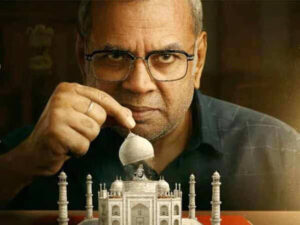Digital News Guru Entertainment Desk:
What’s the film
- The Taj Story is a 2025 Hindi-language film directed by Tushar Amrish Goel and starring Paresh Rawal in the lead role.
- The film presents a courtroom-drama style narrative around the iconic monument Taj Mahal, its history and debates around it.
- It was released theatrically on 31 October 2025.
Box Office & Reception
- On its opening weekend, The Taj Story collected around 5.9 crore in India.
- By Day 11 it had collected approximately 16 crore in India.
- However, the drop‐off has been steep. On its second Monday the film’s collections plunged by over 85 %, earning only around 31 lakh.

How The Taj Story Sparks Debate Over the Taj Mahal
- The film taps into a controversial and sensitive subject—the history of the Taj Mahal—and prompts debate about historical narratives, national identity, monuments and memory.
- Its poster and trailer reportedly stirred controversy, with critics accusing it of pushing ideological viewpoints rather than purely cinematic ones.
- Despite initial word-of-mouth momentum and a strong name like Paresh Rawal attached, the steep drop in box office after the first week signals challenges in sustaining audience interest.
Why this matters & what it means
The film’s journey highlights several broader trends and questions:
- Cinema & contested history
The Taj Mahal is one of India’s most iconic monuments; making a film that revisits its origins is bound to attract attention. The Taj Story enters territory where historical fact, interpretation, myth and identity politics converge. By raising questions around conventional narratives, the film taps into a larger cultural moment — which may have helped initial interest, but also presents risk (of backlash, of critical dismissal). - Performance in a crowded market
Despite the controversies, The Taj Story managed a modest box-office haul given its subject matter and screen count. That demonstrated that niche, message-driven films can find an audience. But the steep drop signals that for a film to sustain beyond the first week, word-of-mouth, critical support or mass appeal must align — in this case they did not sufficiently.
- Implications for trade & production
Trade analysts will watch whether such films — that are more idea-driven than star-driven blockbusters — can become viable models. The film will likely influence how producers view “issue films”, the budgeting, the marketing and the risk they are willing to take. The fact that The Taj Story was able to cross 15 crore is a mark of possible viability, but the drop warns of the limitations. - Public discourse & reception
The film’s trajectory suggests that audience receptivity to politically or historically laden films is variable: initial curiosity may draw viewers, but lasting impact often depends on storytelling strength and resonance. The critical remark that the film “raises provocative questions but stops short of exploring them with nuance” (per Wikipedia summary) highlights that ambition alone doesn’t guarantee success.
In effect, The Taj Story casts a spotlight on how Indian audiences and critics are navigating cinema their narratives of history, identity and entertainment value.
What to watch moving forward
- Whether The Taj Story continues to hold over the coming week, or collapses further—its long-term box office fate remains uncertain.
- How the film performs overseas (if released) and in non-Hindi markets.
- Whether the film’s controversies translate into increased viewership or backlash that affects its commercial run.
- How this film fits into larger trends of Hindi cinema tackling “historical drama” / “national narrative” themes—and whether audiences’ appetite for such films is stable.

Conclusion
The Taj Story is more than a film — it’s a case study in how contemporary Indian cinema navigates the intersection of history, identity, commercial realities and audience reception. With a strong lead in Paresh Rawal, an ambitious premise and a timely cultural backdrop, the film generated buzz and initial traction. Yet the steep drop in its box-office and critical feedback suggest that ambition must be matched with execution and resonance if such projects are to endure.
For viewers, the film raises the question: when cinema interrogates well-known monuments and accepted narratives, does it create meaningful dialogue — or simply spark more controversy without resolution? For trade watchers, the film’s financial arc offers lessons on the risk-reward equation of controversial, message-laden cinema. How The Taj Story plays out in the long term (via digital platforms, home viewing, cultural discourse) may define its legacy more than its box-office numbers.
You May Also Read: India rejects Pakistan’s claims linking Delhi to Islamabad bombing








